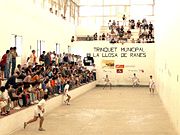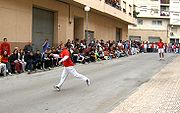
Raspall
Encyclopedia

Valencian pilota
Valencian pilota is a traditional handball sport played in the Valencian Community. Its origins are not known, but seems to be related to the French Jeu de paume....
, played mainly in the Valencian
Valencian Community
The Valencian Community is an autonomous community of Spain located in central and south-eastern Iberian Peninsula. Its capital and largest city is Valencia...
regions south to the Xúquer river
Júcar
The Júcar or Xúquer is a river on the Iberian Peninsula of Spain. The river runs for approximately 509 km from its source at Ojuelos de Valdeminguete, on the eastern flank of the Montes Universales, Sistema Ibérico...
: the Vall d'Albaida
Vall d'Albaida
Vall d'Albaida is a comarca in the province of Valencia, Valencian Community, Spain, of some 722 square kilometers and some 90,000 inhabitants around the year 2008 at some 70 Km of the city of Valencia...
, the Safor
Safor
Safor is a comarca within the province of Valencia, Spain. The capital is the city of Gandia, but also includes the towns of Oliva, Piles and Daimús, among others...
, the Costera
Costera
Costera is a comarca in the province of Valencia, Valencian Community, Spain.- Municipalities :*L'Alcúdia de Crespins*Barxeta*Canals*Cerdà*Estubeny*La Font de la Figuera*Genovés*La Granja de la Costera*Llanera de Ranes*Llocnou d'En Fenollet...
, the Marina Alta
Marina Alta
Marina Alta is a comarca in the province of Alicante, Valencian Community, Spain.- Municipalities :*Adsubia*Alcalalí*Beniarbeig*Benidoleig*Benigembla*Benimeli*Benissa*Benitachell/El Poble Nou de Benitatxell*Calp*Castell de Castells*Dénia...
and the Marina Baixa
Marina Baixa
Marina Baixa is a comarca in the Valencian Community, Spain. It is bordered by the comarques of Comtat on the northwest, Marina Alta on the northeast, Alacantí and Alcoià on the west and the Mediterranean Sea on the east....
. It is also popular in the Ribera Baixa
Ribera Baixa
Ribera Baixa is a comarca in the province of Valencia, Valencian Community, Spain.-Municipalities:*Albalat de la Ribera*Almussafes*Benicull de Xúquer*Corbera*Cullera*Favara*Fortaleny*Llaurí*Polinyà de Xúquer*Riola*Sollana*Sueca...
. It is one of only two variants that have professional players - the other being Escala i corda
Escala i corda
Escala i corda is the most prestigious variant of Valencian pilota, and the only one, with Raspall, that have professional players.- History :...
.
The game may be played either indoors in a trinquet
Valencian trinquet
Valencian trinquet, or simply trinquet , is the court used in the Valencian Community for two different modalities of Valencian pilota: the Escala i corda and the Raspall.- Court :...
or outdoors on the street. In either case the playing area is divided into two halves called the "serving" and "receiving" fields. Among its distinguishing features is the lack of any formal divider between the two halves and the rule that the ball is allowed to bounce as many times as desired. This rule makes the game one of the most energetic variants of Valencian pilota, as the players must frequently stoop to hit the ball close to the ground.
Playing areas
"Raspall" matches may be played in a trinquetValencian trinquet
Valencian trinquet, or simply trinquet , is the court used in the Valencian Community for two different modalities of Valencian pilota: the Escala i corda and the Raspall.- Court :...
or on a street, with some minor changes on the rules.
The playing area is divided in two halves, called the "serving" and the "receiving" fields. Neither net nor line on the ground mark the boundary between the two areas.
If played outdoors, the chosen street must be flat and straight, around 75 m long and 8 m wide. It doesn't matter much if there are some irregularities such as balconies, traffic signals, since they may be used as traps for tricky effects on the ball. The ends of the street are called the "fault lines", that is, if the ball bounces on the ground behind them the defending team loses the "quinze". Spectators may seat behind those "fault lines" or on one of the sidewalks.
When played indoors in a trinquet
Valencian trinquet
Valencian trinquet, or simply trinquet , is the court used in the Valencian Community for two different modalities of Valencian pilota: the Escala i corda and the Raspall.- Court :...
(the most renowned is El Zurdo of Gandia
Gandia
Gandia is a city and municipality in the Valencian Community, Eastern Spain on the Mediterranean. Gandia is located on the Costa del Azahar, 65 km south of Valencia and 96 km north of Alicante....
), fans consider carefully where to sit. The most careful watch the game from the galleries and the bravest and pilota fans sit at the llotgeta. But most sit on the stairs. Since players don't want to throw the ball there, they feel safe.
Ball and clothes

Vaqueta ball
The vaqueta ball is the kind of ball used to play some Valencian pilota variants: Escala i corda, Galotxa and Raspall. Its name derives from the fact that it's made of bull's skin, hence its black colour , this way the ball contrasts with the white colour of the trinquets' walls.- Traits :The...
(Catalan
Catalan language
Catalan is a Romance language, the national and only official language of Andorra and a co-official language in the Spanish autonomous communities of Catalonia, the Balearic Islands and Valencian Community, where it is known as Valencian , as well as in the city of Alghero, on the Italian island...
for little cow ball) is used; it is a small and extremely fast ball, very tough and a good bouncer. The name comes from the fact that it is made of cow leather. The sizes for adults are 42 mm diameter, 138 mm circumference, and 42 grams of weight.
Due to the extreme toughness of this sport, players must wear special protections on the hands: Readying the hand.
Players wear red or blue, red being the colour of the allegedly stronger team or the favourite in the bets. Since they are stooping many times during the match they wear short trousers.
Rules

The winner of a "Raspall" match is the team who attains 25 points (if playing in a trinquet), or 40 points (if on a street). Points are counted in five blocks called jocs. That is, a match is played until a team gets five "jocs". Every "joc" consists of four quinzes: 15, 30, val and joc. Whoever wins the "val" gets the "joc" and scores five points.
Teams play face to face, throwing each other the ball with one hit of the hand until one of them is not able to send it back to the opponents ("fault" by the loser and so a quinze for the winner), or the ball is sent to a place where it can't be thrown back (direct quinze). Those special places are the "llotgeta" and the "galleries" (if the match is played in a trinquet
Valencian trinquet
Valencian trinquet, or simply trinquet , is the court used in the Valencian Community for two different modalities of Valencian pilota: the Escala i corda and the Raspall.- Court :...
or the ball is sent behind the opponent's "line fault" (if it is played on a street).

If the ball is sent to the spectators on the street's sidewalk (or the trinquet's "escales") the ball is immediately "blocked"; that is, it will be placed in the middle of the street or trinquet where it was blocked and a player of the opposing team will hit it from there. This way, it is not convenient that balls get blocked, since players use to be able to throw it up to the "galleries" or far away the "fault line".

